Top News
September 24, 2020 Ryukyu Shimpo
On September 23, in the final regular meeting for the month of the Nago City Assembly (chaired by Hideki Oshiro), the Assembly adopted, by a majority, a 2020 general accounting and finance supplementary budget. The supplemented sum is 2,154,370,000 yen. The supplementary budget includes 40,340,000 yen as the cost of excavation services for preserving record of the former site of the Ourazaki internment camp within the Camp Schwab compound, as well as a 400,000,000 yen increase to the three Kube wards community fund, which uses the capital from the realignment grant acquired due to Futenma Replacement Facility (FRF) construction in the region.
The cost of purchasing the former Muribushi (Okinawa General Bureau Secretariat Training Institute) site in Kise, Nago City, as part of a “workation” (telecommuting to work while sightseeing) location facilities development project and other such expenses totalled upward of 915,310,000 yen. However, given that this project is not seen as a sufficient explanation for the expenses, the Assembly unanimously adopted an additional resolution requesting an explanation from the City.
In the Assembly’s discussion prior to the vote, Zenko Nakamura, who opposed the supplementary budget, claimed “The realignment grant project budget is forcing the military base onto city residents as we head into the future, which will cause us to lose any chance to restore the health of public financial affairs”. Furthermore, Yoshitami Oshiro, who also opposed the supplementary budget, said, in relation to the workation project, “The real estate appraisal is doubtful”.
Naoya Kishimoto, who supported the supplementary budget, had this to say: “The realignment grant is a budget that should be returned to city residents. The mayor is meeting with the chief cabinet secretary and others, and requesting alleviation of military base damages. Just because we accepted the grant does not mean we cannot speak our minds”.
(English translation by T&CT and Erin Jones)
Go to japanese
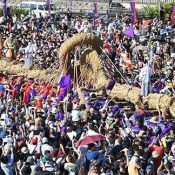
September 22, 2020 Ryukyu Shimpo
In a normal year, summer and fall are busy with traditional events held in each part of Okinawa. These include Honensai, harvest festivals to give thanks for that year’s harvest and pray for a bumper crop the next year; Usudeku, a dance to pray for peace and safety; and Great Tug-of-War events. However, this year, one after another the festivals were scaled down or canceled due to the spread of the novel coronavirus. The citizens of Okinawa pray for an end to the pandemic and look forward to holding the festivals next year. In this article, we have collected pictures from the events of past years to introduce a few of the many traditional events passed down in Okinawa.

Kitsugansai – The Miroku Parade at Kohama Island’s Kitsugan Festival. The festival is designated as an Important Intangible Cultural Property of Japan. (October 22, 2009, Taketomi, Kohama Island)

Shinugu – The Ada Shinugu is designated as an Important Intangible Cultural Property of Japan. (August 28, 2017, Ada, Kunigami)

Hachi-gatsu Odori – The beautiful sisters Ogama and Kuigama appear in the Kumi Odori called Chushin Nakasone Toyomiya-gumi during the August Dance Festival of Tarama. (September 6, 2019, Ntabaru Uganju in Nakasuji, Tarama)

Eisa – The Moromizato Youth Association of Okinawa City enthrall spectators with their powerful Eisa dance. (August 23, 2019, Koza Gate Street, Okinawa City)

Shichi – The Anga Parade led by the Fudachimi, an element unique to the Shichi festival held in the village of Sonai. (October 4, 2001, Maedomari Beach in Iriomote, Iriomote Island)

Bojutsu – At the Honensai of Imadomari, Nakijin, residents display their powerful Bojutsu. (September 10, 2011, Imadomari, Nakijin)

Shishimai – The Lion Dance performed at the Shuri Sueyoshi Jugoya Festival. This dance has a 250-year history. (October 7, 2017, Shuri Sueyoshi Community Center, Naha City)

Pantu – Miyako Island’s Pantu Festival is designated as an Important Intangible Cultural Property of Japan. A child wails after being smeared with mud at the Pantu Punaha in Shimajiri. (October 9, 2012, Hirara, Miyakojima)

Mushama – The teku (taiko) of the Higashi-gumi at Mushama, the largest event on Hateruma Island. (August 14, 2019, Taketomi, Hateruma Island)
(English translation by T&CT and Ellen Huntley)
Go to Japanese
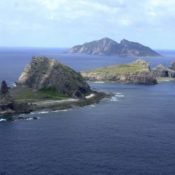
September 18, 2020 Ryukyu Shimpo
Tokyo – The Liberal Democratic Party’s (LDP) National Defense Legislator’s Alliance (NDLA, former Director General of the Japan Defense Agency Seishiro Eto, chairman) authored a proposal September 17, calling for added maintenance and expansion of the airports and ports in the Nansei (Ryukyu) Archipelago for use by the Japanese Self Defense Forces (JSDF), in order to strengthen their effective control over the Senkaku Islands. According to written confirmation from both Japan’s central government and Okinawa Prefecture, the proposal includes Shimojishima Airport, which is recognized as being exclusively for civilian use. The group plans to formally submit the proposal to the Japanese government next week.
The proposal combines policies to strengthen control from three perspectives, defense capability, police presence, and governmental control. It outlines conducting joint training exercises with the JSDF and U.S. military in the area around the Senkaku Islands, and upgrading the ports on Yonaguni Island so that they can harbor Japan Maritime Self-Defense Force (JMSDF) destroyers.
At a meeting on September 17, the alliance explained that a representative from the Ministry of Defense (MoD) has said regarding Shimojishima Airport, “At the present stage, we are not considering using [the airport] as a base for the Japanese Air Self-Defense Force (JASDF).” In the Ryukyu archipelago, the only airport other than Naha Airport that is capable of allowing JASDF fighter aircraft to take-off and land is Shimojishima Airport, and the alliance (head of the secretariat, Councillor Masahisa Sato) indicates, “We want to urge the government to allow fighter aircraft use of the airport.”
(English translation by T&CT and Sam Grieb)
Go to Japanese
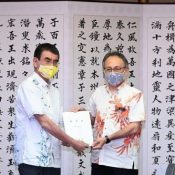
September 19, 2020 Ryukyu Shimpo
On September19, Okinawa Governor Denny Tamaki and Taro Kono, who was recently appointed Minister of State for Okinawa and Northern Territories Affairs, met at the Okinawa Prefectural Office. The governor presented Minister Kono with a letter listing 19 requests for the prefecture. Items in the letter included: government funding for FY 2020 to boost the Okinawan economy, extending the Act on Special Measures for the Promotion and Development of Okinawa which expires in 2021, restoring the fire-ravaged Shurijo Castle, and abandoning the new military base construction plan in Henoko, Nago City. Kono asserted that Okinawa’s proximity to other Asian countries is its “greatest advantage,” and expressed his intention to raise income levels for Okinawans, which is currently the lowest in the country. He said, “I have been involved with Okinawa Prefecture in matters of diplomacy and defense. Going forward, my work will be to support Okinawa’s economy among other domestic affairs.”
Governor Tamaki said, “Okinawa possesses a unique history and geographical location. It took the prefecture 50 years to grow with the help of the Special Measures Act and economic aid from the central government. The seeds that were planted have finally sprouted, and it is beginning to flourish into a majestic tree. We have proven our potential.” The governor stressed that he will “continue to learn from mistakes and work hard to advance the open gateway to Asia.”
Minister Kono also met with Okinawa Prefectural Assembly Chair Noboru Akamine during his trip.
(English translation by T&CT and Monica Shingaki)
Go to Japanese
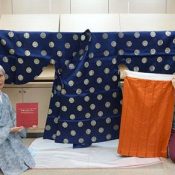
September 17, 2020 Ryukyu Shimpo
On September 16, Fusako Kumagai, director of Kumagai Wa Ryusai Kimono Vocational School in Naha, donated four reproductions of official attire from the Ryukyu Kingdom to the Naha City Museum of History. The four reproductions are based on articles in the museum’s collection. Yoko Yamada, curator of the museum, says, “Most of the research on royal attire of the Ryukyu Kingdom thus far has been focused on patterns and materials. In these pieces, the sewing technique has been replicated. It is a major contribution to the study of the history of the Ryukyu Kingdom.”
The donated pieces were made with a focus on reconstructing sewing techniques in a total of four items from the Naha City Museum of History collection: the royal shozoku vestment called a toisho jacket, a shirojidujin white undergarment, hakama trousers, and a mo (or kun) skirt. The material for the toisho jacket was procured from Fujian, China so that the it would be similar to that of the original. However, because the procured material is made from synthetic fibers, the fabric of the original and the reproduction are different.
Director Kumagai says, “Due to insufficient funding, the materials and the workmanship in the toisho are lacking. I want to find a good time to make another reproduction and exchange them.” She continues, “I hope that many Okinawans will come to the Naha City Museum of History and that they’ll take some time to admire the culture of hand-sewing while they are there.”
Curator Yamada says, “The royal garments in the collection can only be on display for 30 days each year because of preservation concerns. I look forward to using Director Kumagai’s donations to the fullest.”
(English translation by T&CT and Ellen Huntley)
Go to Japanese
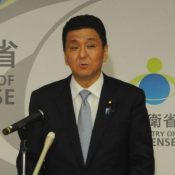
September17, 2020 Ryukyu Shimpo online edition
In the early morning hours of September 17, at his inaugural interview, Defense Minister Nobuo Kishi said, concerning relocation of Futenma Air Station to Henoko, Nago City, “On the basis of the principle that there is one sole solution, it is certain that steadily carrying forward with construction [of the Futenma Replacement Facility in Henoko] will lead to the soonest possible return [of land to Okinawa]”, thereby expressing his intention hold to the political policy under the Abe administration.
Defense Minister Kishi is Shinzo Abe’s brother, and was inaugurated as Defense Minister in the Suga Cabinet on September 16. Kishi explained that he has received instructions from Prime Minister Yoshihide Suga to handle the implementation of military base burden reduction in Okinawa, and further said that Prime Minister Suga “conscientiously explained his way of thinking in terms of removing the risks of Futenma Air Station and relocating it to Henoko, explained the government’s efforts in implementing a visible reduction of the military base burden on Okinawa, and expressed that he wants to strive to gain local understanding [of these matters]”.
(English translation by T&CT and Erin Jones)
Go to Japanese
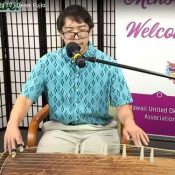
September 16, 2020 Ryukyu Shimpo
Derek Fujio, president of the classical Okinawan koto school Ryukyu Sokyoku Koyo Kai Hawaii Shibu (branch), made a guest appearance on Hawaii United Okinawa Association’s YouTube channel “HUOA Yuntaku Live!” Fujio performed three solo songs on the koto and sanshin, sharing the charm of koto music and Okinawan folk songs with the viewers.
The Hawaii United Okinawa Association launched “HUOA Yuntaku Live!” on April 16 to provide a platform for its members to interact during the novel coronavirus pandemic. New videos are posted almost every week and showcase traditional Okinawan performers in areas such as Ryukyu dance, sanshin, koto, and drums.
Fujio performed the Ryukyu koto solo music Kagiyadefu Bushi and Karaya Bushi, and played the Ashimiji Bushi on a sanshin, which is often performed in Eisa during Obon festivals.
Fujio said, “Many Hawaiian performers have appeared on the channel. I want the people of Okinawa to see that HUOA members are inheriting the culture.”
Check out Derek Fujio on “HUOA Yuntaku Live!” at: https://www.youtube.com/watch?v=wyllkpbuFcg (or from the QR code below).
(English translation by T&CT and Monica Shingaki)
Go to Japanese
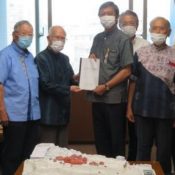
September 17, 2020 by Ryukyu Shimpo
The committee to preserve and open to the public the 32nd Army Headquarters Shelter (Eiki Senaha, chairman) met with Okinawa vice-governor Kiichiro Jahana at the Okinawa Prefectural Office September 16, where they submitted a proposal to designate the 32nd Army Headquarters Shelter as a “peace education site,” to preserve it, and open it to the public. Vice-governor Jahana commented, “Our views are aligned [with the committee]. Considering the historical significance, it should be a location that informs about peace, and we will form a new investigative committee to once again look into doing so,” and indicated that the new committee will discuss the message of peace and passing down of history to future generations.
Vice-governor Jahana also commented, “The investigative committee will look into preserving and opening the site to the public. Since we consider this the last chance to do so, we want to accomplish this during the current administration,” indicating a strong resolve to realize the proposal. He explained that the investigative committee will investigate using modern techniques for keeping the location open to the public, and will discuss the recovery of the remains of soldiers.
At the proposal, former gubernatorial research chief Akari Takayama reflected on the particulars of his decision to maintain and make the site public during his tenure as research chief, and requested, “Along with the reconstruction of Shuri Castle’s main hall, I would like to see the remains around the headquarters be maintained and opened to the public.” Vice governor Jahana commented, “We are not only concerned with the loss of Shuri Castle from the fire, but also taking serious consideration for the 32nd Army Headquarters.”
(English Translation by T&CT and Sam Grieb)
Go to Japanese
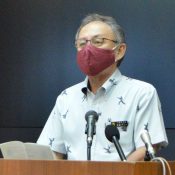
September 14, 2020 Ryukyu Shimpo Digital Edition
On the afternoon of September 14, Okinawa’s Governor Denny Tamaki stated, regarding the election of Chief Cabinet Secretary Yoshihide Suga as the new president of the Liberal Democratic Party, “The new President Suga prides himself on having worked hard to reduce the burden of bases on Okinawa as a person in charge of base burden reduction. I hope to see him continue to work for a realistic reduction of the base burden, and also to sincerely grapple with the problems faced by us here in Okinawa like the elimination of the dangers posed by Futenma Air Station, which has long been of great concern, and the new base construction in Henoko, and to make active efforts to arrange an opportunity to resolve the problems through dialogue.”
Regarding Suga’s election as the new president, Governor Tamaki stated, “first, I would like to offer him my heartfelt congratulations. I believe he was selected as president with high expectations because of all of his efforts up until now in his important roles in government as Minister of Internal Affairs and Communications and Chief Cabinet Secretary and his experience, knowledge, and close familiarity with policy.” He then stated, “I would like to express my hopes that [Suga] will work hard” to get the country back on its feet while being faced with challenges in many areas such as the citizens’ daily lives, the economy, education, and medicine which have been severely impacted by the COVID-19 pandemic.
(English translation by T&CT and Sandi Aritza)
Go to Japanese

September 12, 2020 Ryukyu Shimpo
By Hideaki Yoneda
Countless dragonflies and winter birds in search of food have appeared in the mountains and paddy fields of Tokashiki Island, announcing the arrival of fall after the tropical storm Haishen hit the region.
Dozens of winter birds like the Black-winged stilt (H. himantopus), nicknamed the “waterside ballerina” for the way it wades in water for food, and other birds of the sandpiper family have been observed in the paddy fields of Tokashiki. In different parts of the island, residents are
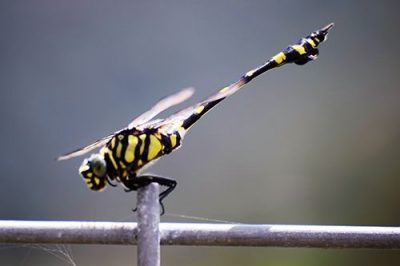
Photograph 2: An Ictinogomphus pertinax in a paddy field in Tokashiki Village on September 8.
enjoying the sight of numerous dragonfly species.
(English translation by T&CT and Monica Shingaki)
Go to Japanese
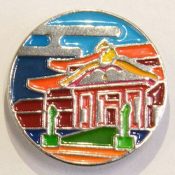
October 15, 2020 Ryukyu Shimpo
The Okinawa Association of Corporate Executives (OACE) have created a “Shuri Castle Badge” in an effort to aid the reconstruction of Shuri Castle, which burned down in October of last year, and the badge is now available to purchase. The badge depicts an illustration of the castle, and adopts the 17-hue color scheme of the UN Sustainable Development Goals (SDGs) color wheel. The OACE plans to contribute the proceeds to the reconstruction of Shuri Castle, and is hoping the badge finds a large audience among Okinawans.
Each badge costs 1,000 yen, the group will make 10,000 of the badges, and they are calling for member companies among others to make purchases. According to the association, they are predicting that the first batch will result in a contribution of 7 million yen, and are planning to produce more if it picks up in popularity.
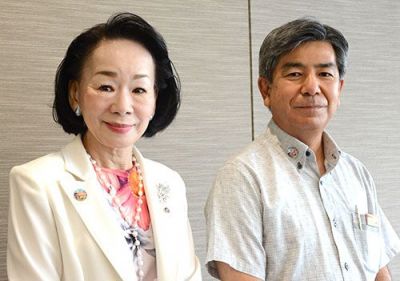
OACE representatives Miki Fuchibe (left) and Yasushi Kawakami (right) with Shuri Castle Badges on their collars. September 14, at the Ryukyu Shimpo offices
OACE chairwoman Miki Fuchibe (president of the board at JCC), visited the Ryukyu Shimpo offices on September 14, and said, “We want the people of Okinawa to once again as one overcome the economic difficulties caused by the coronavirus, and to help build momentum for the reconstruction of Shuri Castle.” OACE chairman Yasushi Kawakami (President of the Bank of the Ryukyus) said, “We were able to make a badge that shows the color of Okinawa using the colors for the SGDs. I would like the badge to spread throughout the prefecture.”
Badges can be purchased individually in units of 10 (10,000 yen, not including shipping) using a form on the OACE website
(https://okidouyukai.jp/news/4594.html).
(English translation by T&CT and Sam Grieb)
Go to Japanese






















 Webcam(Kokusai Street)
Webcam(Kokusai Street)


